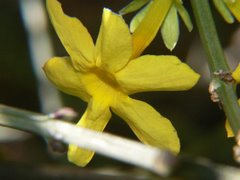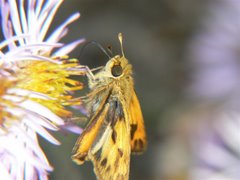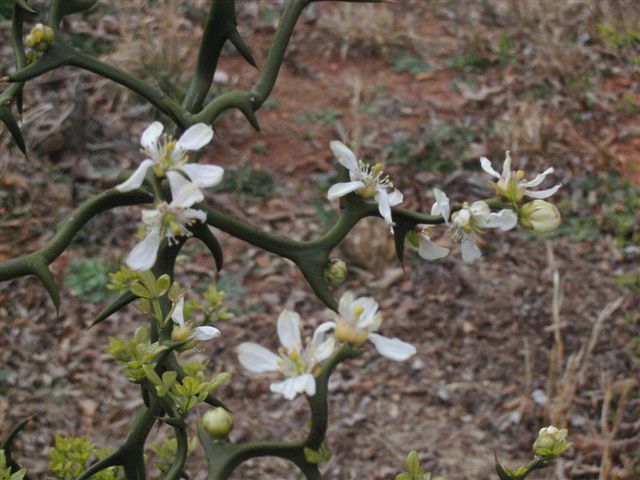When I was getting near the back, I came upon an almost impenetrable stand of saw briar (Smilex bono-nox) which must have stretched 30 feet across, in front of me and on the west side. Not wanting to backtrack, I looked for a hole where I thought I could get through unscathed - but somehow a branch I was holding away from me slipped from my hand and raked several long, ugly scratches on my arm. Blood was pooling in big drops when I remembered the tissue in my fanny pack. I pressed it tightly over the cuts and continued to make my way through the rest of the stand, now using only one hand.
Smilex bono-nox

After seeing the state of the buckeyes, I decided I would not return the way I had come but headed west where the undergrowth was not so dense. I was just thinking, “No saw briars here, thank goodness!” when I came upon thick brambles of blackberries ((Rubus fruticosus). A long scrape on my shin is a souvenir from my encounter with them!
Rubus fruticosus

The next day some fluid-filled blisters were proof that when I leaned on my elbows to get that close-up of the rue-anemone (Anemonella thalictroides), I didn’t look close enough for the poison ivy (Toxicodendron radicans) that grows all over our land. They are tiny when they first leaf out and sometimes difficult to spot.
Toxicodendron radicans

What started out to be a nice springtime tramp in the woods had turned out to be a walk on the wild side! If you’ve ever been pricked by the thorns of a rose or a blackberry, you’ve done battle with a plant, though you may be only an innocent bystander. I’m not in the habit of eating blackberry or saw briar leaves but other animals browse on them. Since plants must keep their leaves in order to make the energy they need to grow, many have evolved ways of protecting themselves. In the case of the blackberry and saw briar, their defense is something like a barbed wire fence. Poison ivy, on the other hand, has evolved a different form. It produces an oily chemical, urushiol, which produces severe pain in the digestive tract when eaten. Herbivores soon learn to avoid it, as do humans, like me, who develop a skin rash when they come in contact with the chemical. You don’t have to make contact with the leaves to be affected either, as touching the stem or the woody vine that clings to trees will do it. That’s why you can get a poison ivy rash in the dead of winter.
This Black Swallowtail is inexperienced or not allergic!

Even when I’m enduring the itch of my poison ivy or nursing my scratches, I’ve got to admire those plants. They can’t run and hide but they sure can put up a fight!
We can complain because rose bushes have thorns
…or we can rejoice because thorn bushes have roses.
- St. Francis de Sales




1 comment:
Saw briars are an essential part of the legend of the 100 mile trail race called The Barkley Marathons, held in early April in Frozen Head Park in Tennessee.
Post a Comment